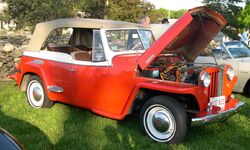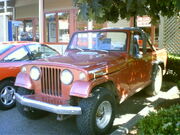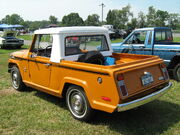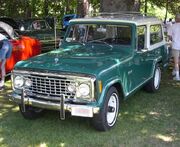 | |
| Manufacturer |
Willys Kaiser-Jeep |
|---|---|
| Production | 1948–1950 |
| Class | SUV |
| Body style(s) | 2-door Convertible |
| Wheelbase | 101 in (2,565 mm) |
| Related |
Willys-Overland Truck Willys-Overland Station Wagon |
The Jeepster is an automobile sold under the Jeep marque, originally produced by Willys-Overland from 1948 to 1950.
The Jeepster name was revived in 1966 on a new model, the C-101 Jeepster Commando, and American Motors (AMC) (successor to Willys-Overland) removed the Jeepster name for 1972, ending production after 1973.
VJ[]
The original Willys-Overland Jeepster ("VJ" internally) was produced from 1949 through 1950, although some leftover models were sold under the 1951 model year. After World War II, Jeep trademark owner, Willys, believed that the market for the military-type Jeep would be limited to farmers and foresters, therefore they began producing the "CJ" (or Civilian Jeep) to fill this growing segment as well as producing the new Jeep Wagon in 1946, and then the Jeep Truck in 1947.
Realizing a gap in their product line up, Willys developed the Jeepster to crossover from their "utilitarian" type truck vehicles, to the passenger automobile market. The car was originally only offered with rear-wheel drive, thus limiting its appeal with traditional Jeep customers. While its distinctive boxy styling (created by industrial designer Brooks Stevens) was a hit with critics, it did not catch on with the intended market segment. Sales were also limited by sparse advertising. In the end, 19,132 original VJ Jeepsters were produced (1948 - 10,326; 1949 - 2,960; 1950 - 5,836).[1]
The VJ Jeepster was powered by the 62 horsepower (46 kW) "Go Devil" engine, a 134 cu in (2.2 L) straight-4 also used in the CJ. A 3-speed manual transmission with optional overdrive was used, as were drum brakes all around. The vehicle's front end and single transverse leaf spring suspension, was from the Willys Station Wagon, as was the rear driveline. The flat-topped rear fenders were copied from the Jeep truck line, as were the pair of longitudinal rear leaf springs.
Engines:
- 1948-1950 - L134 Go Devil I4 — 134.1 CID (2,197 cc)[1]
- 1949-1950 - L148 Lightning I6 —148.5 CID (2,433 cc)[1]
- 1950 - F134 Hurricane I4 —134.2 CID (2,199 cc)[1]
- 1950 - L161 Lightning I6 —161 CID (2,638 cc)[1]
Model Variations[]
- VJ-2
The VJ-2 Jeepster was built on a Willys chassis and began production with a one-model/one-engine offering. Due to poor marketing, high price and weak performance sales were low and few were produced. The following year the VJ-3 was produced.
- VJ-3
The VJ-3 Jeepster had very little standard equipment. This time there were two engines offered, changing the Jeepster's designations to VJ-3 4-63 for the four-cylinder and VJ-3 6-63 for the Lightning-equipped six-cylinder. In 1950, there was a redesigned front end and new engines and designations dependent on what part of the year it was. Early 1950s four-cylinder Jeepsters were VJ-3 463, and the six-cylinder Jeepsters were VJ-3 663. The later-year Jeepsters were VJ-473 and VJ-673, respectively. The hood and grille also put the V in VJ in 1950, when the design took on that shape. [1]
C101[]
| It has been suggested that [[::Jeepster Commando|Jeepster Commando]] be merged into this article or section. (Discuss) |

Well-used 1969 Jeepster

1971 Jeepster Commando SC-1 pickup
The Jeepster was revived in 1966 in the form of the Jeepster Commando ("C101"). The F-head Hurricane straight-4 was used (a direct descendant of the original Go Devil engine) and four-wheel drive was finally added. This engine produced 75 horsepower (56 kW) at 4000 rpm and 114 lb·ft (155 N·m) of torque at 2000 rpm. The 160 horsepower (119 kW) Dauntless V6 was optional and preferred with its 235 lb·ft (319 N·m) of torque. A total of 57,350 Kaiser-spec "C101" Jeepster Commandos were sold between 1966 and 1971.
Body styles of the Jeepster Commando included station wagon, convertible, pickup, and roadster. The deluxe station wagon included sliding rear windows and full interior trim — and available two-tone exterior.
The 1971 Hurst Jeepster built with modifications by Hurst Performance is possibly the scarcest model of all production Jeeps.[2] Standard equipment included a Champagne White exterior with red and blue stripes, a roof rack, a sports steering wheel, and Goodyear G70 x 15 raised white letter tires mounted on wider steel wheels. Hurst equipment included special exterior insignia, an 8,000-rpm tachometer on the back of the hood scoop in the driver's line of sight, as well as a Hurst T-handle shifter on manual-transmission cars or a console-mounted Hurst Dual-Gate shifter with the optional automatic transmission.[2]
The Jeepster Commando came in three types: Revival Jeepster, Commando convertible, and an open body roadster with no top at all. The Revival Jeepster, named "Jeepster", as shown in hood side emblem an VIN decode or Jeepster Convertible was the showcase vehicle of the fleet, offering deluxe interior appointments, powered convertible top, and a Continental tire kit (available only for this model). The Commando convertible offered the same body with just the basic finish and equipment.
Engines:
- 1966-1971 - F134 Hurricane I4 —134.2 CID (2,199 cc),[1] 75 hp (55 kW) and 114 ft·lbf (154 N·m)
- 1966-1971 - Dauntless 225 V6—225.3 CID (3,692 cc), 3.75 in (95 mm) bore, 3.40 in (86 mm) stroke, 160 hp (119 kW) and 235 ft·lbf (318 N·m)[3]
C104[]

1972 Jeep Commando (C104)
The Jeepster name was removed after 1971, but the model remained in production for two more years as the Jeep Commando. In 1972, it received a "conventional" full-width grille (see picture). The Commando had one of three AMC engines, the 232 cu in (3.8 L) or 258 cu in (4.2 L) AMC Straight-6 or the 304 cu in (5 L) AMC V8. A total of 20,223 AMC-spec "C104" Jeep Commandos were made in 1972 and 1973.
Engines:
- 1971-1972 - AMC 232 I6— 231.91 CID (3,800.3 cc),[4] 3.750 in (95.3 mm) bore, 3.500 in (88.9 mm) stroke, 100 hp (74 kW) and 185 ft·lbf (250 N·m)[5]
- 1971-1972 - AMC 258 I6—258.08 CID (4,229.2 cc),[4] 3.750 in (95.3 mm) bore, 3.895 in (98.9 mm) stroke[5]
- 1971-1972 - AMC–304 V8—303.92 CID (4,980.3 cc),[4] 3.750 in (95.3 mm) bore, 3.753 in (95.3 mm) stroke[5]
References[]
| This page uses some content from Wikipedia. The original article was at Willys-Overland Jeepster. The list of authors can be seen in the page history. As with Tractor & Construction Plant Wiki, the text of Wikipedia is available under the Creative Commons by Attribution License and/or GNU Free Documentation License. Please check page history for when the original article was copied to Wikia |
- ↑ 1.0 1.1 1.2 1.3 1.4 1.5 Matar, George. "1948-1951 Jeepster" Hemmings Classic Car - December 1, 2005 retrieved on August 28, 2008.
- ↑ 2.0 2.1 Foster, Pat. "The Forgotten Hurst" Hemmings Muscle Machines, June 1, 2005 retrieved on August 28, 2008.
- ↑ "Jeep Engine Dauntless: Buick 225 V6". Jeep tech. Retrieved on 2008-04-30.
- ↑ 4.0 4.1 4.2 "Engine application chart". Retrieved on 2008-04-30.
- ↑ 5.0 5.1 5.2 "General Engine Specifications". Retrieved on 2008-04-30.
External links[]
| Jeep road vehicle timeline, 1945–1970s — next » | |||||||||||||||||||||||||||||||||||
|---|---|---|---|---|---|---|---|---|---|---|---|---|---|---|---|---|---|---|---|---|---|---|---|---|---|---|---|---|---|---|---|---|---|---|---|
| Type | 1940s | 1950s | 1960s | 1970s | |||||||||||||||||||||||||||||||
| 5 | 6 | 7 | 8 | 9 | 0 | 1 | 2 | 3 | 4 | 5 | 6 | 7 | 8 | 9 | 0 | 1 | 2 | 3 | 4 | 5 | 6 | 7 | 8 | 9 | 0 | 1 | 2 | 3 | 4 | 5 | 6 | 7 | 8 | 9 | |
| Traditional | CJ-2A | CJ-3A | CJ-5 | ||||||||||||||||||||||||||||||||
| CJ-3B | CJ-7 | ||||||||||||||||||||||||||||||||||
| CJ-6 | |||||||||||||||||||||||||||||||||||
| Dispatcher | DJ-3A | DJ-5/6 | |||||||||||||||||||||||||||||||||
| Compact SUV | VJ | C101 | C104 | ||||||||||||||||||||||||||||||||
| SUV | Willys Jeep Wagon | Jeep Cherokee (SJ) | |||||||||||||||||||||||||||||||||
| Wagoneer SJ | |||||||||||||||||||||||||||||||||||
| Compact pickup | Commando | ||||||||||||||||||||||||||||||||||
| Full-size pickup | Willys Jeep Truck | ||||||||||||||||||||||||||||||||||
| Gladiator | Honcho/J10-20 Series | ||||||||||||||||||||||||||||||||||
| Truck | Forward Control | ||||||||||||||||||||||||||||||||||
| Van | FJ-3/3A | ||||||||||||||||||||||||||||||||||